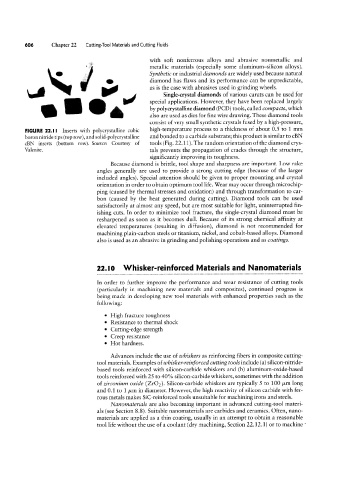Page 625 - 04. Subyek Engineering Materials - Manufacturing, Engineering and Technology SI 6th Edition - Serope Kalpakjian, Stephen Schmid (2009)
P. 625
606 Chapter 22 Cutting-Tool Materials and Cutting Fluids
with soft nonferrous alloys and abrasive nonmetallic and
metallic materials (especially some aluminum-silicon alloys).
Synthetic or industrial diamonds are widely used because natural
Q diamond has flaws and its performance can be unpredictable,
as is the case with abrasives used in grinding wheels.
O special applications. However, they have been replaced largely
Single-crystal diamonds of various carats can be used for
by polycrystalline diamond (PCD) tools, called compacts, which
also are used as dies for fine wire drawing. These diamond tools
consist of very small synthetic crystals fused by a high-pressure,
|:|Gu|;5 22_|| Inserts with polycrystalline Cubic high-temperature process to a thickness of about 0.5 to 1 mm
boron nitride tips (top row), and solid-polycrystalline and bonded to a carbide substrate; this product is similar to cBN
cBN inserts (bottom row). Source: Courtesy of tools (Fig. 22.1 1). The random orientation of the diamond crys-
Valenite. tals prevents the propagation of cracks through the structure,
significantly improving its toughness.
Because diamond is brittle, tool shape and sharpness are important. Low rake
angles generally are used to provide a strong cutting edge (because of the larger
included angles). Special attention should be given to proper mounting and crystal
orientation in order to obtain optimum tool life. Wear may occur through microchip-
ping (caused by thermal stresses and oxidation) and through transformation to car-
bon (caused by the heat generated during cutting). Diamond tools can be used
satisfactorily at almost any speed, but are most suitable for light, uninterrupted fin-
ishing cuts. In order to minimize tool fracture, the single-crystal diamond must be
resharpened as soon as it becomes dull. Because of its strong chemical affinity at
elevated temperatures (resulting in diffusion), diamond is not recommended for
machining plain-carbon steels or titanium, nickel, and cobalt-based alloys. Diamond
also is used as an abrasive in grinding and polishing operations and as coatings.
22.10 Whisker-reinforced Materials and Nanomaterials
In order to further improve the performance and wear resistance of cutting tools
(particularly in machining new materials and composites), continued progress is
being made in developing new tool materials with enhanced properties such as the
following:
° High fracture toughness
° Resistance to thermal shock
° Cutting-edge strength
° Creep resistance
° Hot hardness.
Advances include the use of whiskers as reinforcing fibers in composite cutting-
tool materials. Examples of whisker-reinforced cutting tools include (a) silicon-nitride-
based tools reinforced with silicon-carbide whiskers and (b) aluminum-oxide-based
tools reinforced with 25 to 40% silicon-carbide whiskers, sometimes with the addition
of zirconium oxide (ZrO2). Silicon-carbide whiskers are typically 5 to 100 /tm long
and 0.1 to 1 /.tm in diameter. However, the high reactivity of silicon carbide with fer-
rous metals makes SiC-reinforced tools unsuitable for machining irons and steels.
Nanomaterials are also becoming important in advanced cutting-tool materi-
als (see Section 8.8). Suitable nanomaterials are carbides and ceramics. Often, nano-
materials are applied as a thin coating, usually in an attempt to obtain a reasonable
tool life without the use of a coolant (dry machining, Section 22.12.1) or to machine

